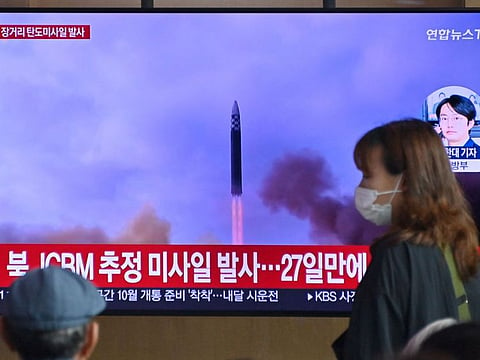North Korea fires its first ICBM in 3 months after making threat over alleged US spy flights
South Korea, Japan and US agree to sternly deal with North Korean provocations

SEOUL: North Korea fired its first intercontinental ballistic missile in three months on Wednesday, two days after it threatened “shocking” consequences to protest what it called provocative US reconnaissance activity near its territory.
Some experts say North Korea likely launched its developmenta, road-mobile Hwasong-18 ICBM, a type of solid-fuel weapon that is harder to detect and intercept than its liquid-fuel ICBMs. North Korean leader Kim Jong Un previously called the Hwasong-18 his most powerful nuclear weapon.
The missile fired from North Korea’s capital region around 10am flew about 1,000km at a maximum altitude of 6,000km before landing in waters between the Korean Peninsula and Japan, according to South Korean and Japanese assessments. They said the missile was launched on a high angle, in an apparent attempt to avoid neighbouring countries.
South Korea’s military called the launch “a grave provocation” and urged North Korea to refrain from additional launches. Chief Japanese Cabinet Secretary Hirokazu Matsuno denounced North Korea’s repeated missile launches as “threats to the peace and safety of Japan, the region and international society.”
In a trilateral phone call, the chief nuclear envoys of South Korea, Japan and the US agreed to sternly deal with North Korean provocations and boost their coordination to promote a stronger international response to the North’s nuclear and missile programmes, according to Seoul’s Foreign Ministry.
The launch came while South Korean President Yoon Suk Yeol and Japanese Prime Minister Fumio Kishida are attending the Nato summit in Vilnius, Lithuania. In an emergency meeting of South Korea’s security council convened by video in Lithuania, Yoon warned North Korea would face more powerful international sanctions due to its illicit weapons programs.
North Korea’s ICBM program targets the mainland US while its shorter-range missiles are designed to hit South Korea and Japan, both key American allies in northeast Asia.
North’s counterattack capabilities
Since 2017, North Korea has performed a slew of ICBM tests, but some experts say the North still has some technologies to master to possess functioning nuclear-armed missiles capable of reaching major US cities.
The North’s most recent previous ICBM test was the first launch of the Hwasong-18 in April. After that launch, Kim said the missile would enhance the North’s counterattack capabilities and ordered the expansion of his country’s nuclear arsenal to “constantly strike extreme uneasiness and horror” in its rivals.
Missiles with built-in solid propellants would be easier to move and hide, making it difficult for opponents to detect their launches in advance. All of North Korea’s previous ICBM tests used liquid fuel.
Kim Dong-yub, a professor at the University of North Korean Studies in Seoul, said Wednesday’s launch appeared to be the North’s second flight-test of the Hwasong-18.
The launch, the North’s first weapons firing in about a month, came after North Korea earlier this week released a series of statements accusing the United States of flying a military spy plane close to its soil.
In a statement Monday night , Kim’s sister and top adviser, Kim Yo Jong, warned the United States of “a shocking incident” as she claimed that the US spy plane flew over the North’s eastern exclusive economic zone eight times earlier in the day. She claimed the North scrambled warplanes to chase away the US plane.
Sign up for the Daily Briefing
Get the latest news and updates straight to your inbox



